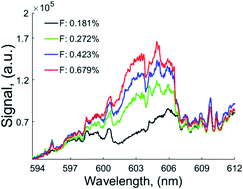Quantitative fluorine and bromine detection under ambient conditions via molecular emission
Abstract
The fluorine and bromine limits of detection (LoDs), based on emission from CaF and CaBr, using Microwave-assisted Laser Induced Breakdown Spectroscopy (MW-LIBS) have been determined. The molecular emission bands of CaF and CaBr in the spectral range of 605 nm and 627.1 nm are utilised for quantitative fluorine and bromine detection. The optimum gating has been established for CaF, at 603.3 nm and 605 nm, following 1.5 ms long microwave pulses. The MW-LIBS plasma temperature and electron density against laser energy have been demonstrated at constant microwave power coupling to optimise laser energy using Ca I lines. A linear relationship between the CaF signal strength and fluorine concentration, and CaBr signal strength and bromine in cement has been validated. The recorded limits of fluorine and bromine detection were 106 ± 6 μg g−1 and 0.2 ± 0.04%, respectively. The results represent an improved detection limit at low laser energy and 4-fold improved detection limit for bromine.



 Please wait while we load your content...
Please wait while we load your content...